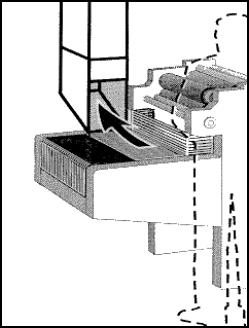Controlling Cleaning-Solvent Vapors at Small Printers
1998
DHHS (NIOSH) Publication Number 98-107
Hazard
Press operators and other workers in printing establishments are exposed to airborne solvent vapors generated when the press is cleaned. Press-cleaning solutions are generally a mixture of chemicals that include various solvents, some of which are carcinogens. Adverse health effects from inhalation or skin contact include dermatitis, headaches, nausea, vomiting, dizziness, respiratory failure, central nervous system depression, coughing, difficult breathing, chest pains, unconsciousness, and death. Chronic effects may include kidney and liver damage. Many press operators in small print shops have excessive exposures because these shops frequently have inadequate ventilation or other controls for the vapors.
Controls
NIOSH researchers have demonstrated a control that reduces exposures to cleaning-solvent vapors to acceptable concentrations. This approach includes substitution, ventilation, work practices, and personal protective equipment.
Substitution
Cleaning solutions should not contain potential carcinogens. Examples of commonly chemical carcinogens to avoid are methylene chloride, benzene, and perchloroethylene. Carcinogens are listed on the manufacturer’s Material Safety Data Sheet if they are present at concentrations of 0.1% or higher.
Ventilation
Local exhaust ventilation (LEV) is effective because the offending material is removed at the source before it can mix with workroom air. Cleaning solvent that has vaporized and become airborne can be quickly captured and removed by the proper application of LEV to each press. The ILLUSTRATION shows a LEV system that NIOSH has found effective. The exhaust takeoff is attached to the top edge of the press above the paper delivery area and close to the roller train. The airflow rate through the 7- by 10-in. takeoff opening is 470 cubic feet per minute. The duct should be sized to maintain a minimum velocity of about 3,000 ft/min if anti-offset powder is being used. The air should be exhausted outside the building and away from potential re-entry points such as fresh-air inlets and windows. Fresh, tempered, and humidified makeup air should be supplied in amounts equal to the exhausted air. The cost of tempering the makeup air can be reduced substantially by using a heat recovery method such as an air-to-air heat exchanger. Air drafts near the presses should be minimized (reduced to less than 50 ft/min) by properly located air-supply inlets, barriers, or traffic rerouting. Floor fans should not be used around the presses.
Work Practices
Wipers used for cleaning become saturated with cleaning solvents and should be stored in a closed container until they are removed from the shop to prevent inhalation of vapors.
Squeeze bottles used to apply the cleaning solvents are filled from larger containers. These containers should be located in a separate, well-ventilated room or at least close to an exhaust inlet to avoid over-exposures from the filling operation.
Personal Protective Equipment
Many liquid cleaning solvents are absorbed through the skin. Therefore, chemical protective gloves should be worn whenever skin contact is possible. These solvents often penetrate or permeate generic materials such as natural rubber latex gloves (i.e., surgical gloves). The manufacturer of the cleaning solution and the gloves can provide recommendations for the appropriate chemical protective gloves. But first, the Personal Protective Equipment Section on the Material Safety Data Sheet should be consulted for recommendations.
Illustration: Local Exhaust Ventilation for Small Printer

For general approaches to the design of ventilation systems and examples of a large number of local exhaust applications, refer to the following publication: American Conference of Governmental Industrial Hygienists. A manual of recommended practice, 22nd ed. Cincinnati, OH [1995].
*NIOSH is the Federal agency responsible for conducting research and recommending measures for preventing work-related illnesses and injuries. All HAZARD CONTROLS are based on research studies that show how worker exposure to hazardous agents or activities can be significantly reduced.
Acknowledgments
The principal contributors to this publication are Keith G. Crouch, Rosmarie T. Hagedorn, Richard Carlson, and Jerome P. Flesch.
This document is in the public domain and may be freely copied or reprinted. NIOSH encourages all readers of this HAZARD CONTROLS to make it available to all interested employers and workers.
